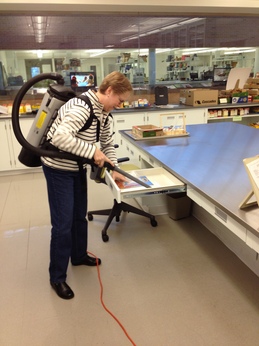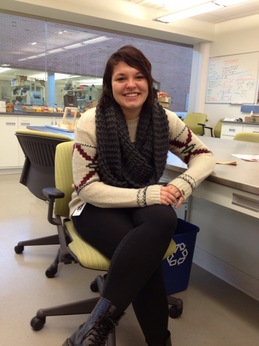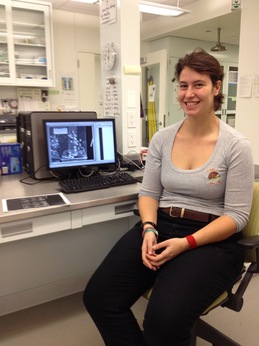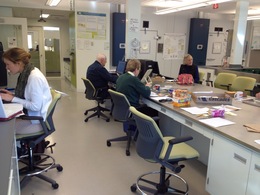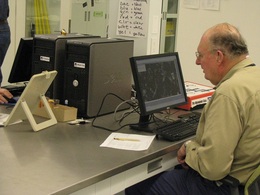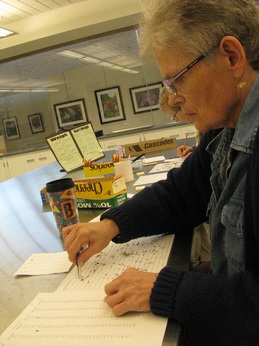|
|
Something about springtime makes you more aware of the layers of grime covering every surface of your life. Thankfully, volunteers Leslie and Anne agreed to help us battle the accumulated dust throughout lab. Believe it or not, this is a vacuum cleaner, not a ghost-busting device.

Now that the lab is sparkling, clean, and free of ghosts, we can continue our scientific endeavors in a grime-free environment.
Our volunteers have been making progress in counting, randomizing, and weighing Echinacea achenes from 2011 and cleaning achenes from 2012. We are over half-way through randomizing and weighing achenes from the sizable 1999 experiment and have made progress counting achenes from the remaining 2011 harvest. And what better way to celebrate progress than with heart-shaped cookies, courtesy of Bob’s wife (Bob is on the left, counting achenes)?

In other news, intern Jill Pastick is making progress with her experiment comparing Echinacea germination on agar vs. blotter paper. Last week she transferred the newly-germinated sprouts from petri dishes to plug trays in order to monitor their growth. So far, it looks like the agar method worked well in promoting germination and minimizing mold. However, we will know more once Jill analyzes the data on germination rates and seedling growth. The results of this pilot study will help guide our methods in two upcoming germination experiments.

We have two interns pursuing independent projects in the lab. Jill Pastick, a junior at Lakeforest College, is testing out different methods of germinating Echinacea achenes and helping us prepare the germination phase of two ongoing experiments.

Gia Hallaman, a junior at Northwestern, is helping out with several projects, including counting achenes in x-ray images from Jill’s germination experiment (you can see them on the computer screen below). She is also learning how to identify ants to morphospecies. That means distinguishing different species based on morphology and making our best guess on which species they are. It takes time to develop an eye for the different traits that distinguish closely related species; often the most obvious traits, like color and size, are not informative for differentiating species. Jill is learning to use a combination of tools, including online dichotomous keys and photo databases (antweb.org), to identify ants to species or morphospecies. With her help, we should be able to make a dent in identifying the ants we collected from Minnesota prairie remnants in the summer of 2012.

This week has involved a combination of new projects and ongoing endeavors.
First of all, I should mention that the Echinacea Project is hiring field interns for the summer of 2013. See https://echinaceaproject.org/opportunities/ for more information about job openings.
The volunteers have continued making progress in processing Echinacea heads harvested in 2011. We are nearly halfway through weighing achenes from an experiment planted in 1999 and have have obtained achene counts for 3 of the 9 experiments in the main experimental plot. The volunteers are working on counting achenes for the remaining experiments and on cleaning Echinacea heads harvested in 2012.
More projects has meant more people in the lab. On Thursday, we had a vibrant crowd of five volunteers and two student interns.

One of these interns (not shown in the picture) is Jill Pastick, a junior at Lakeforest college who will be working in the lab until May. Her project will involve germinating achenes from one or two ongoing experiments. One of these experiments is examining hybridization between two species of Echinacea: the native E. angustifolia (the one we work on) and the non-native E. pallida. This summer, Shona Sanford-Long (a junior at Middlebury College) performed experimental crosses of E. angustifolia and E. pallida growing in a Minnesota prairie restoration and is currently analyzing her results to assess the success of different parental combinations in producing fertile achenes. The other experiment examines the effects of burning on offspring fitness in E. angustifolia. Last summer, Kelly Kapsar (a junior at Carleton College) recorded the flowering phenology of Echinacea in burned and unburned units of a prairie preserve. Several interns have been involved in cleaning and weighing the achenes from those plants.The next step in both of these experiments will be to germinate the achenes in the lab and plant them in an experimental plot in Minnesota.
By Marie Schaedel
Most Echinacea heads have achenes with a clear weight gap between full and empty, which is useful for lab purposes. Sometimes, however, there is no clear difference in weight for full and empty achenes. This winter, I took a closer look at achenes from Echinacea heads that had a continuous pattern of variation in weight to see if there was another way to distinguish between full and empty achenes when the weight test failed. To do this, I reweighed achenes from 20 samples that lacked an obvious weight cutoff. After plotting the new weights in R, I gathered X-ray images of the achenes closest to my best-guess cutoff weight for each sample. I found that more than half of the samples I tested had an intermediate transition weight that divided the full from empty populations of achenes. For ambiguous cases in which there is no clear difference in weight between full and empty achenes, this transition weight can be used to predict the cutoff value.
Read more:What to do when the Weight Test Fails.pdfAppendix
Figures

Figure 1

Figure 2

Figure 3

Figure 4

Figure 5
X-Ray Images

12139.1_top_red

14011.1_bot_bac

14142.1_bot_wht

14142.1_top_wht

14142.2_bot_grn

14142.2_top_grn

14143.1_bot_grn

14143.1_top_grn

14143.2_bot_wht

14963.2_bot_bac

14963.2_top_bac

17019.1_bot_wht

17019.1_top_wht

17134.2_bot_wht

17134.2_top_wht

17172.1_bot_red

17172.1_top_red

17294.1_bot_clr

17294.1_top_clr

6417.1_top_blu
Photograph Images

12139.1_top_red: Close-up of two achenes with a transition weight

14142.1_top_wht: Close-up of two achenes with a transition weight




















Mindy Runge & Ale Mendoza participated in a mini-internship in the Echinacea lab at the Chicago Botanic Garden this fall. They are in Lynn Westley’s Plant Biology class at Lake Forest College.
Mindy & Ale investigated seed set in Echinacea heads from a prairie remnant in western Minnesota. They compared seed set in tops and bottoms of heads (florets at the bottom of a head flower first). In the process of answering their question, they learned how to dissect achenes from Echinacea seed heads, how to operate our high-tech seed balance, and how to organize datasets.

Ale and Mindy dissecting seedheads
We made a lot of progress this week. First, the volunteers finished the first round of counting for one of the larger experimental plots. There are still two more rounds of counting to finish, but we’re mostly there.
Suzanne started taking inventory of the heads we harvested this year. It didn’t take her long to get through everything, considering flowering was so low this year. Out of about 500 heads, there was only one that was mislabeled. There were a few missing, but they are on their way back from Minnesota.

I’ve been busy trying to identify all the ant specimens we have pinned. Right now it looks like we have two species of Lasius, five species of Formica, and one species each in several other genera. There are also multiple species within the genus Myrmica, but I haven’t identified them yet. Apparently that genus is particularly difficult to identify.
Now that the summer field season has come to an end, it is time to focus on what’s going on in the lab at the Chicago Botanic Gardens. I am taking over for Josh as lab manager and have spent most of the week learning my way around the lab.
Since I arrived, the two major tasks for the volunteers have been counting, randomizing, and weighing achenes from heads collected in 2011.
Here is Aldo, using the computer to count achenes from a scanned image:

Once we have a count of achenes for each head, we select a random sample for weighing. Here is Char, randomizing achenes based on a numbered grid:

As for the 2012 harvest, we brought a little over 500 heads from the main experimental plot. This is much less than the 2890 heads collected last year. Our haul from this year also includes heads from Kelly’s phenology study, heads from Shona’s hybridization experiment, and a sizable collection of ants from prairie remnants. We have plenty of work in store for the coming months.
Here is Sebastian Di Clemente’s final report on the main project of his internship:
|
|

